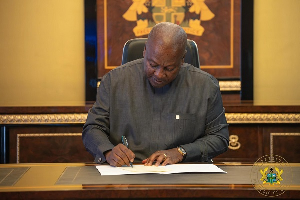Health News of Thursday, 21 February 2008
Source: GNA
HIV Prevalence declines to 1.9 percent
Accra, Feb. 21, GNA - Ghana's HIV prevalence for 2007 has decline from 2.22 per cent in 2006 to 1.9 percent this year, indicating a stabilizing condition, Dr Nii Akwei Addo Programme Manager of the National AIDS Control Programme (NACP) said on Thursday.
He said the highest prevalence among the 15 to 24 year group was recorded in the Eastern Regional town of Agomanya and Asikuma Odoben Brakwa in the Central Region which recorded 6.2 percent respectively. Agomanya also recorded the overall highest prevalence with 8.9 percent from 8.4 percent in 2006 with Krachi rural in the Northern Volta recording the lowest of 0.3 per cent.
Regionally, Eastern Region recorded the highest of 4.2 percent, Ashanti 3.8, Greater Accra 3.4 percent, Brong Ahafo 3.3 percent, Upper West 3.3 percent, Western, 3.2 percent, Central 2.9 percent, Upper East 2.5, Volta 2.0 and Northern Region 1.7 percent.
Presenting the findings of the HIV Sentinel Survey conducted in 40 sentinel sites strategically located in 17 rural sites, 23 urban sites and 69 antenatal clinics, Dr Addo said the age group prevalence showed two peaks among 25 to 29 years and 35 to 39 years.
He said there were an estimated number of 264,481 persons living with HIV and AIDS 10,666 of whom were males and 153,815 females. In all 180,899 cumulative AIDS deaths have been recorded. Dr. Addo explained that HIV was more prevalent in the urban areas, recording an estimated 2.25 percent and lower in rural communities where 1.66 percent was recorded.
He explained that four of the 40 sites Agomanya, Wa, Fanteakwa and Obuasi recorded prevalence above five percent as it was in 2006. Agomanya recorded 8.9 per cent, Wa recorded 5.8, Fanteakwa recorded 5.8 per cent whilst Obuasi recorded 5.0 per cent describing the figure for Wa as "very worrying for which attention must be given".
In all, 16, 947 children have been infected with HIV with 2,959 annual HIV positive births. For new infection in adults, a total of 21,310 people were infected, while 2,959 children were newly infected. Dr Addo noted that there were 81, 409 adults from 15 years up who needed the Anti Retroviral Therapy (ART) and 5, 106 children also on ART and regretted that "not much had been done for children who needed to be on ART"".
Projecting from 2007 to 2012, Dr Addo said the number of persons living with HIV and AIDS would increase from 264, 481 to 296,088 whilst cumulative deaths would also increase from 180,899 in 2007 to 266, 933 by 2012.
He commended health workers, the Ghana AIDS Commission (GAC), Ministry of Health, Ghana Health Service and other donor partners, including the WHO and DFID for their technical and financial support in ensuring that the HIV prevalence of the country was reduced to its barest minimum and called for more support since "this is the period that we need you most to be more successful".
Professor Sakyi Awuku Amoa, Director-General of GAC called for the need to intensify activities for the youth and alert them that HIV had no cure therefore, they needed to protect themselves.
"They must know that there is more to it, that the risk is still there and there is more life ahead of them and therefore they must not rush to get infected", he added.
He attributed the success to the interventions including the 99 per cent awareness creation, introduction of Voluntary Counselling and Testing (VCT) services, which allowed people to know their status. "The introduction of the mobile VCT had also played a major role because people did not have walk to the hospital but it was brought your doorsteps".
Professor Fred T. Sai, Presidential Advisor on HIV and AIDS, Reproductive Health and Population chaired the ceremony and reiterated the need to intensify efforts in ensuring that the youth were protected.












